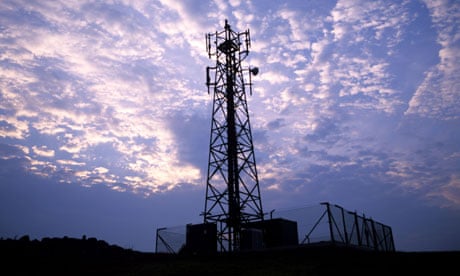Do mobile phone towers make people more likely to procreate? Could it be possible that mobile phone radiation somehow aids fertilisation, or maybe there's just something romantic about a mobile phone transmitter mast protruding from the landscape?
These questions are our natural response to learning that variation in the number of mobile phone masts across the country exactly matches variation in the number of live births. For every extra mobile phone mast in an area, there are 17.6 more babies born above the national average.
This was discovered by taking the publicly available data on the number of mobile phone masts in each county across the United Kingdom and then matching it against the live birth data for the same counties. When a regression line is calculated it has a "correlation coefficient" (a measure of how good the match is) of 98.1 out of 100. To be "statistically significant" a pattern in a dataset needs to be less than 5% likely to be found in random data (known as a "p-value"), and the masts-births correlation only has a 0.00003% probability of occurring by chance.
The match between mobile phone towers and birth rates is an extremely strong correlation and it is highly statistically significant. There is no doubting the mathematical finding that more mobile phone masts mean that there will also be more births. This is about as rigorous as statistics can get.
Mobile phone masts, however, have absolutely no bearing on the number of births. There is no causal link between the masts and the births despite the strong correlation. Both the number of mobile phone transmitters and the number of live births are linked to a third, independent factor: the local population size. As the population of an area goes up, so do both the number of mobile phone users and the number people giving birth.
The problem is that our first instinct is to assume that a correlation means that one factor is causing the other. While this does not cause a problem when using pattern-spotting as an evolved survival tool, it does cause severe problems when assessing possible health scares based on a recently uncovered correlation. For the majority of cases, correlation does not indicate the presence of causality.
To investigate a possible causal link requires careful mathematical untangling of false-positive correlations. This is what a team of researchers did at Imperial College London when they were looking for a link between childhood cancer and exposure to radiation from mobile phone transmitters. They obtained location data for 1,397 children who had experienced some form of childhood cancer. For each of these children, they then found four random children who had been born at the same time but had never had cancer. These two case groups were then compared in terms of the number and strength of mobile transmitters where their mothers lived during pregnancy and their early childhood.
This particular study into childhood cancers – along with every other robust study investigating possible links between mobile phones and health – found no causal link.
But would the media turn a correlation-only finding into a causation-based health scare? To find out, I have released my mobile masts and births results as a press release. We'll see if anyone jumps to the conclusion that mobile phone radiation really can give conception a helping hand.
Listen to Matt discuss his finding on More or Less, BBC Radio4 at 13:30 today, Friday 17 December. Or check the Guardian website on Monday 20 December to see what Matt reports back.
Data sources

Comments (…)
Sign in or create your Guardian account to join the discussion